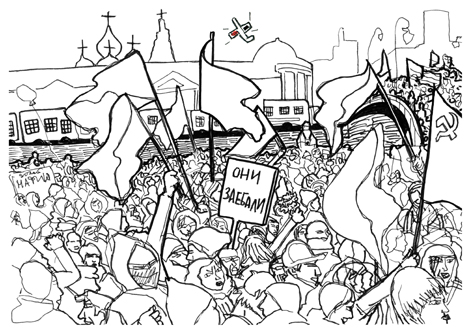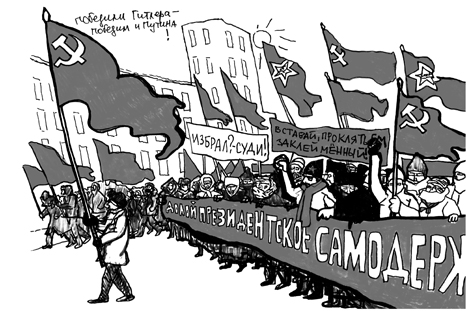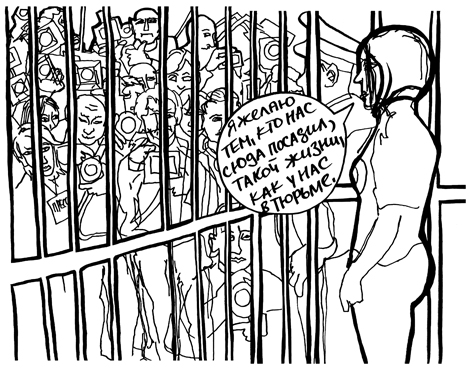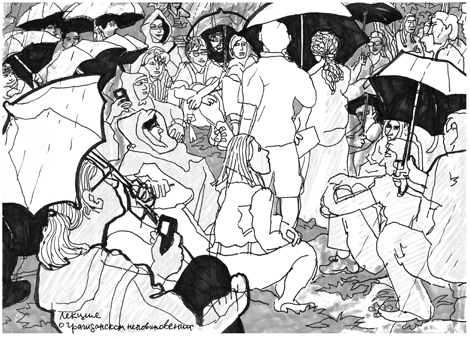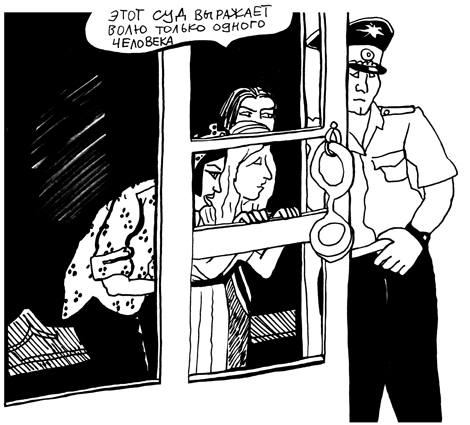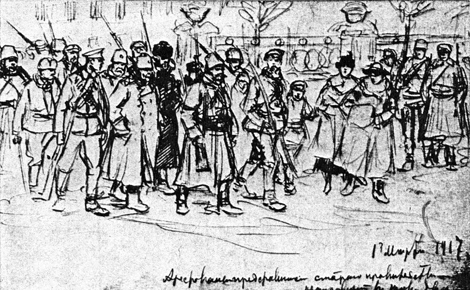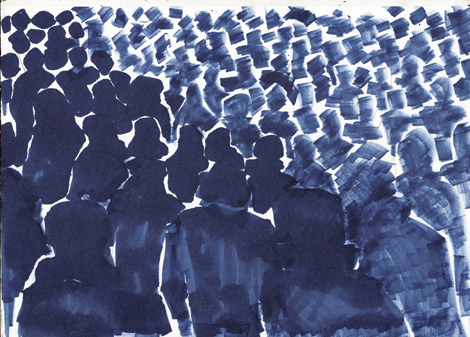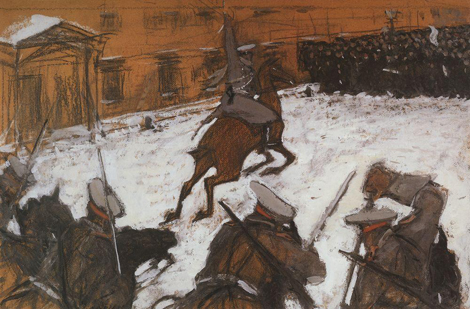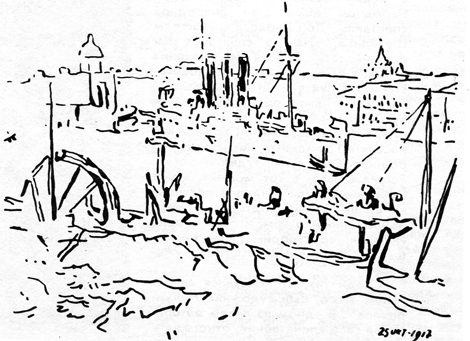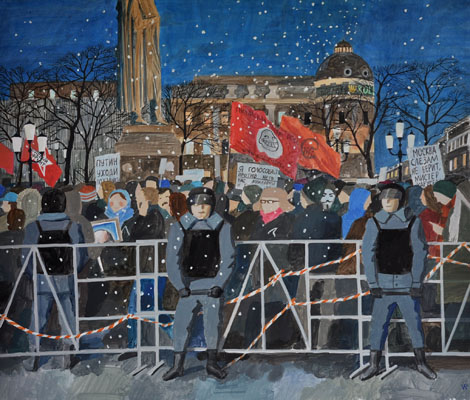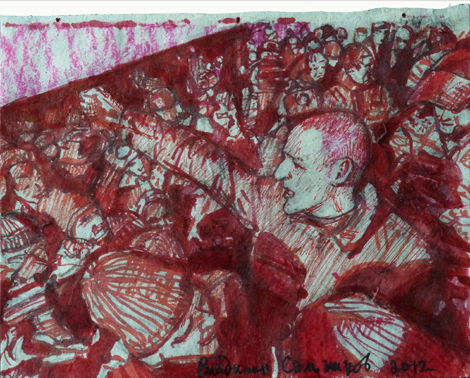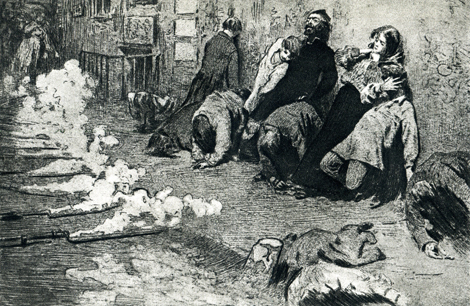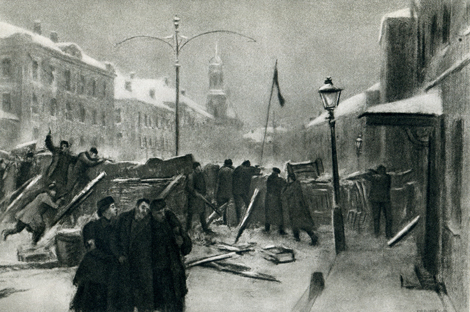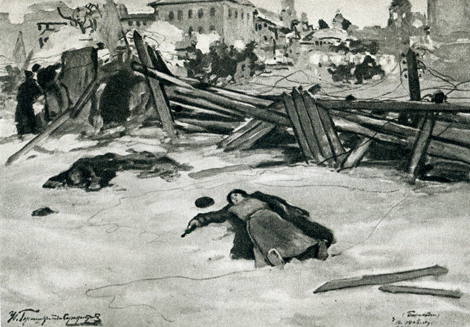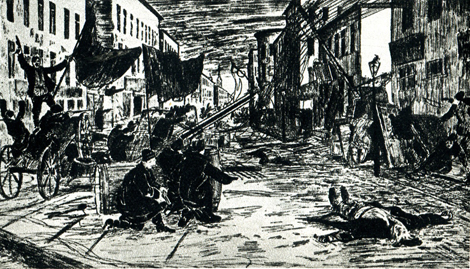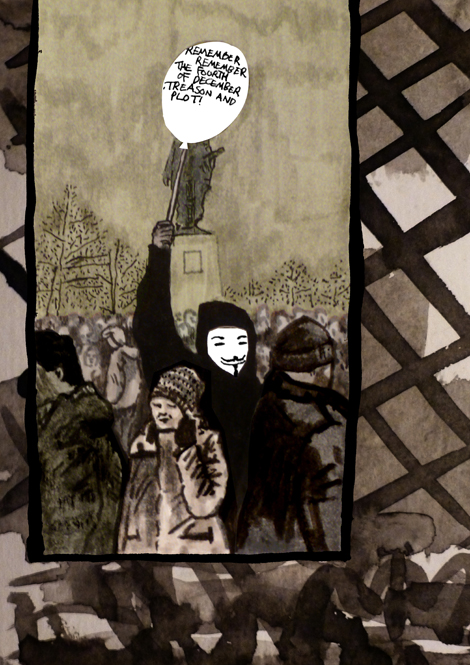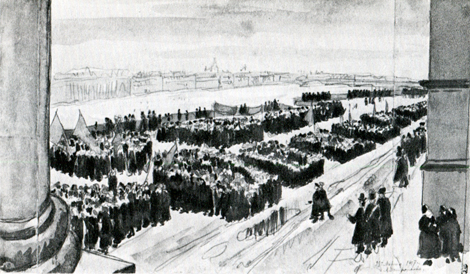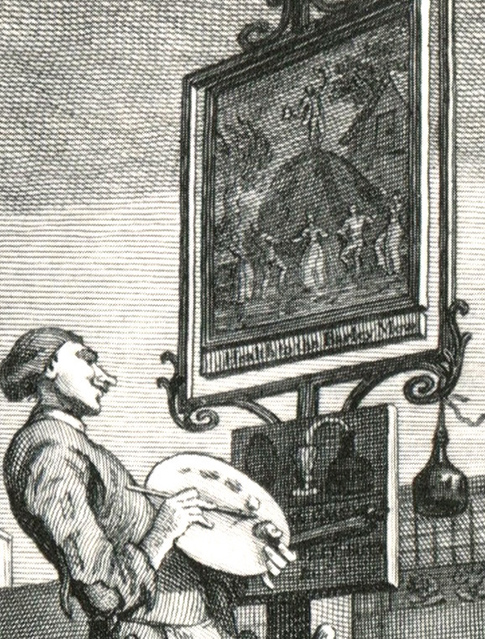Victoria Lomasko]
[October 14, 2013
Portraying Protest
Nicht übersetzt:
Beginning with elections to the Russian State Duma, in December 2011, and ending with the third so-called March of the Millions, in September 2012, I kept a graphical Chronicle of Resistance, meaning that I sketched all the major opposition rallies and protest events in Moscow.
——————————————————————————
Excerpts of Victoria Lomasko´s Chronicle of Resistance:
December 10, 2011: Slogan on placard: We’re fucking tired of them. (News of the arrests on Triumfalnaya added even more fire to people’s desire to protest. Around forty thousand people signed up for a “Rally for Honest Elections” on Facebook.)
February 4, 2012: Caption (upper left): We beat Hitler, we’ll beat Putin! Slogan on banner: Down with presidential autocracy! ( On a frosty afternoon, the so-called March for Fair Elections proceeded from Bolshaya Yakimanka to Bolotnaya Square in four columns—a non-aligned “civic” column, liberals, right-wingers and leftists)
April 19, 2012: Nadezhda Tolokonnikova: I wish the people who have put us here a life in prison like ours. (In between the thousands-strong rallies, “Pussy Riot Court Festivals” were held outside courthouses where the hearings in the Pussy Riot case took place. Artists were heavily involved in these protests, producing leaflets and placards, and organizing performances.)
May 10–16, 2012: Caption: Lecture on civil disobedience (The Occupy Abay camp took shape at Chistye Prudy the next morning. More and more activists kept coming, some with foam pads, sleeping bags, food, guitars and samizdat publications. People enthusiastically conversed and sang lots of Viktor Tsoi songs.)
25 July 31–August 17, 2012: Pussy Riot: This trial expresses the will of one person. (The Khamovniki District Court began hearing the trial in the Pussy Riot case on July 31. I was able to attend the fifth and sixth hearings. Hundreds of journalists covered the trial, and the hearings were broadcast live, so my drawings played no special role in the general media flow.)
——————————————————————————
I was interested not only in sketching the protests but also in analyzing the work of other artists who were drawing these same rallies, as well as studying Russian graphic art that portrays revolutionary events (strikes, demonstrations, fighting on the barricades, etc.) from the revolutions of 1905 and 1917. I wanted to understand the different ways of treating this subject, and so I divided all depictions into three categories.
1. Reportage style. Specific historic events are depicted, and the drawings are filled with many authentic details. Viewers recognize the time, the place and the people portrayed.
Reportage drawings were popular in the nineteenth and earlier twentieth centuries, until photography became more practical and expeditious. There existed the profession of artist-correspondent, someone who drew armed hostilities, high society events, expeditions and so forth for magazines and newspapers. In tsarist-era Russia, the most famous war artists were Nikolai Samokish and Ivan Vladimirov.
In 1905, Vladimirov began sketching everything connected with the revolution. In 1917, so as to be at the center of events, he joined the ranks of the militia [i.e., the pro-revolutionary police], thus becoming not only an observer but also an active participant in the revolution. During his time in the militia, Vladimirov always carried sketchpads with him. Here is a passage from a 1917 article about a group show of artists where his works were exhibited:
Were it not for a number of topical pieces by Vladimirov, no one would say this was not a Nicholavean era exhibition. […] During the first days of the new regime, Vladimirov, a white armband on his sleeve and a rifle slung over his shoulder, performed his civic duties as a militiaman. The whole revolution unfolded and passed before his eyes. That is why all these speeding trucks, bristling with dozens of bayonets, and these attacks on precinct houses and roofs where the [tsarist-era] police had dug in, are so authentic and true.
Ivan Vladimirov, Members of the Old Government Are Arrested, 1917. From the series The February Revolution of 1917. Reproduced in A.I. Roshchin, Ivan Alexeevich Vladimirov: Life and Work, 1869–1947 (Leningrad: Khudozhnik RSFSR, 1974)
When photography became a mass phenomenon, reportage drawings lost their practical utility. But it is obvious to me that photography cannot replace them.
2. Signifying protest. The artist’s impression of an event or even series of events is generalized and distilled into a laconic visual-artistic expression. Many contemporary artists prefer this approach. For example, when drawing protest rallies, David Ter-Oganyan aims for maximum simplification: I would call his works “logos of protest.” Sveta Shuvaeva works in the same vein. Her graphic works are somehow reminiscent of the experimental trends of the 1920s.
Sveta Shuvaeva, Moscow, 2012. Markers on paper. Property of the author
3. Equating actual events with symbols. Specific historic events are depicted with the details necessary for the viewer to identify them. At the same time, though, the degree of generalization is such that the depiction grows into a symbol or archetype.
An example of this is Valentin Serov’s brilliant work “Soldiers, Brave Lads, Where Is Your Glory?”
Valentin Serov, “Soldiers, Brave Lads, Where Is Your Glory?”, 1905. Pastels on cardboard-mounted paper. State Russian Museum, Saint Petersburg
It depicts the events of Bloody Sunday (January 22, 1905, when a peaceful march by workers in Petersburg to petition Tsar Nicholas II was fired on by imperial guards, resulting in heavy casualties), which Serov saw from a window at the Academy of Arts. The viewer recognizes what event is being depicted, but at the same time she is referred to all such events—to all massacres of unarmed crowds.
Serov described his impressions of Bloody Sunday to Ilya Repin: “I will never forget what I was forced to see from a window of the Academy of Arts on January . The restrained, majestic, unarmed crowd moving forwards towards attacking cavalry and rifle sights was a horrible spectacle.”
Images of protest differ not only in terms of specificity and generalization. It is also interesting to understand the artist’s place vis-à-vis the events she depicts. Does she share the sentiments of protesters? Does she attend the rallies she depicts? Does she draw from life, from memory or from photos and videos?
As an artist, I need to be wholly embedded, to be drawing at the scene, talking with the people involved and being one of them myself. One of my goals was to make “portraits of rallies.” It was not a matter of depicting lots of details but of capturing the total energy of what was happening. I imagined each rally as a huge entity endowed with a collective consciousness: every rally was different.
The artist-reporter cannot simply replace the camera, but he does become a conduit for collective emotions. For example, Stepan Yaremich’s reportage drawing The Cruiser Aurora on the Neva, October 25, 1917, made during the Russian naval cruiser’s historic blank shot signaling the start of the October Revolution, is completely devoid of descriptiveness. It is simply a bundle of energy on the paper.
Stepan Yaremich, The Cruiser Aurora on the Neva, October 25, 1917, 1917. Ink on paper. Reproduced in V.P. Lapshin, The Artistic Life of Moscow and Petrograd in 1917 (Moscow: Sovetskii khudozhnik, 1983)
There were artists involved in the Moscow opposition protest rallies who preferred to draw at home from memory, videos and photos. Here is how Sveta Shuvaeva describes her working method:
I do all the pictures from memory, but sometimes I make sketches from videos on YouTube. Artistic form is the main thing for me, not flirting with a leftist political position. I express my civic stance at the rallies themselves by chanting slogans or helping to hold banners. Since there is a temporal distance between events and the moment I began drawing them, unexpected touches and ideas can emerge while I am working on a picture.
An active participant of the rallies, Radik Vildanov made his large, finished drawings at home, using his own photos.
Radik Vildanov, Protest Rally, March 25, 2012, 2012. Acrylics on paper, collage. Property of the author
Despite similar working methods (drawing from memory, photos and videos), Shuvaeva’s works are very different from Vildanov’s. Vildanov is not afraid to indulge in narrative and act as a storyteller: we feel his sympathy and interest in the people he depicts. To my mind, Shuvaeva’s works are interesting in the way they teeter on the brink between figurative and abstract art.
Some artists did not share the enthusiasm of the protesters. They pointedly did not go to the rallies and treated both sides—the authorities and the opposition—with a grain of salt. As artist Alexei Yorsh says, “I work under the impression made by the media deluge passing before my eyes: mostly images from the Internet, YouTube videos, reports by independent news agencies, blogs and web sites. I try and find an image that distils the essence of this deluge.”
The title of Vladimir Salnikov’s series of graphic works, Photographic Evidence of the Winter Insurrection, itself tells us that the artist has consciously chosen to remain an observer not involved in the events. The series is based on the notion of “leaders and masses.” Putin and Medvedev, opposition leaders and rank-and-file protesters are depicted in an identically aloof manner: it is clear they are all only puppets in a gigantic play.
Vladimir Salnikov, from the series Photographic Evidence of the Winter Insurrection, 2012. Markers on paper. Property of the author
The degree to which artists can be alienated from the events they depict can be clearly seen in works from the 1940s dealing with the revolutions of 1905 and 1917. The artists of the forties had a good grasp of the history, and their drawings are often impeccably composed. To my mind, though, they lack the “accidents,” homeliness and “dirt” we always find in drawings produced by eyewitnesses.
Moreover, during the Stalinist terror, artists were forced into rigid self-censorship: not only did they have to remove unsightly details but they also had to give events a romantic tint. For example, we can compare a 1905 etching by Sergei Ivanov, who spent all his time on the streets observing and drawing during the revolutionary demonstrations in Moscow, and a pastel by the Kukryniksy from the 1940s. Both works depict mass executions. In Ivanov’s etching, the people who have been shot collapse like rag dolls, and death is terrifying. In the pastel by the Kukryniksy, on the contrary, the dying men behave like actors on a stage, forming a flawless composition as they slump to the ground.
Sergei Ivanov, At the Wall, 1906. Etching. Reproduced in The Year 1905 in Paintings, Drawings and Sculptures (Moscow: Gosudarstvennoe izdatel’stvo izobrazitel’nogo iskusstva, 1955)
Another pastel by the Kukryniksy, Barricades in Moscow, seems altogether sentimental. A pretty nurse with a Red Cross armband on her sleeve leads a wounded man away from the barricades, while in the background an unhurried skirmish is under way, and a flag is raised.
Kukryniksy, Barricades in Moscow, 1940. Pastel on paper. Reproduced in The Year 1905 in Paintings, Drawings and Sculptures (Moscow: Gosudarstvennoe izdatel’stvo izobrazitel’nogo iskusstva, 1955)
In drawings produced by witnesses of the Moscow uprisings of 1905, we see that the barricades are constructed from garbage and that there are dead bodies everywhere, including those of women. The stippling and hatching in these works is extremely nervous: even before you take in the story you already sense that a tragedy is being depicted.
Ivan Goryushkin-Sorokopudov, A Barricade in 1905, 1905. Gouache. Reproduced in The Year 1905 in Paintings, Drawings and Sculptures (Moscow: Gosudarstvennoe izdatel’stvo izobrazitel’nogo iskusstva, 1955)
Nikolai Shestopalov, The Last Barricade, 1905. Drawing for the anthology Magnificent Moscow. Reproduced in The Year 1905 in Paintings, Drawings and Sculptures (Moscow: Gosudarstvennoe izdatel’stvo izobrazitel’nogo iskusstva, 1955)
The contemporary artists who portray the protest movement work in different genres and forms, such as series of graphic works (Vladimir Salnikov and Sveta Shuvaeva), large-scale easel pieces (Radik Vildanov) and “murals” on masking paper (Alexei Yorsh).
I work in the genre of graphic reportage, which combines three elements: documentary drawings, verbatim quotations of people involved in the events and my own commentary, which provides a single viewpoint and often differs from the stances of the people depicted in the reportages.
The Krutenko sisters, Lyuba and Tamara, occasionally did sketches at the rallies, but more interesting are the drawings where they combine the grotesque with real impressions of events. There are many elements of caricature in these works. English artist Christopher Rainbow drew at one of the first major rallies in Moscow, on December 10, 2011. Despite the fact that he did the drawings on the spot, his works resemble illustrations rather than graphic reportage. Rainbow immediately stylized what he saw, distilling specific details into symbols.
Christopher Rainbow, from the series Bolotnaya Ploshad, 2011 (Property of the author)
Portraits are a rare occurrence in contemporary portrayals of protests. The portraits of activists in Vladimir Salnikov’s Photographic Evidence of the Winter Insurrection and my Chronicle of Resistance are exceptions.
Contemporary artists also rarely work in the “revolutionary landscape” genre, in which the main subject is the city, transformed by the movement of masses of people. One specimen of the genre is the graphic works of Anna Ostroumova-Lebedeva, who in 1917 brilliantly depicted the altered rhythm of revolutionary Petrograd.
Anna Ostroumova-Lebedeva, Demonstration, April 18, 1917, 1917. Ink on paper. Reproduced in V.P. Lapshin, The Artistic Life of Moscow and Petrograd in 1917 (Moscow: Sovetskii khudozhnik, 1983)
No documentary comics or graphic novels portraying protests have yet appeared in Russia. I think this has to do with the Soviet legacy: the principle of the unity of time, place and action was the basis of realist art. Even in the few comics published in satirical and children’s periodicals during Soviet times, each frame was a finished, non-fragmented composition, with the action progressively unfolding from frame to frame. Basically, these were not comics in the European sense, but illustrated stories. The comics way of thinking—in terms of double-page spreads, wild fragmentation and narrative leaps in space and time within a single page—is not congenial to many artists formed during the Soviet and post-Soviet periods.
It seems to me that the endless variety of the graphic styles, genres and approaches adopted by artists renders moot the question of why one should draw protest rallies when thousands of peoples photograph and videotape them. In terms of its idiom, even the most descriptive reportage differs from a photograph, and even more from a video. The idiom of graphical works, especially black-and-white ones, is quite conventional: viewers see images formed by lines, stipples and hatch lines. The artists freely combines different moments in time, shifts space, adds or alters the lighting, removes minor details standing in the way of the whole composition and stresses and sharpens what is important. The minimalism of line drawings is reminiscent of poetry and music, not of photography. And text can be harmoniously incorporated into drawings and prints.
A year has passed since the Moscow protests culminated, but the drawings made at the time were not ephemeral: they continue to arouse our interest. The greater the distance that separates us from the events they portray, the more historical value these works acquire.
Victoria Lomasko, 2013 (Translation: Thomas Campbell)
The article is published in cooperation with the exhibition” Drawing Protest”, Galerie für Zeitgenössische Kunst Leipzig, 19.10.2013 – 09.01.2014, curated by Olga Vostretsova.
